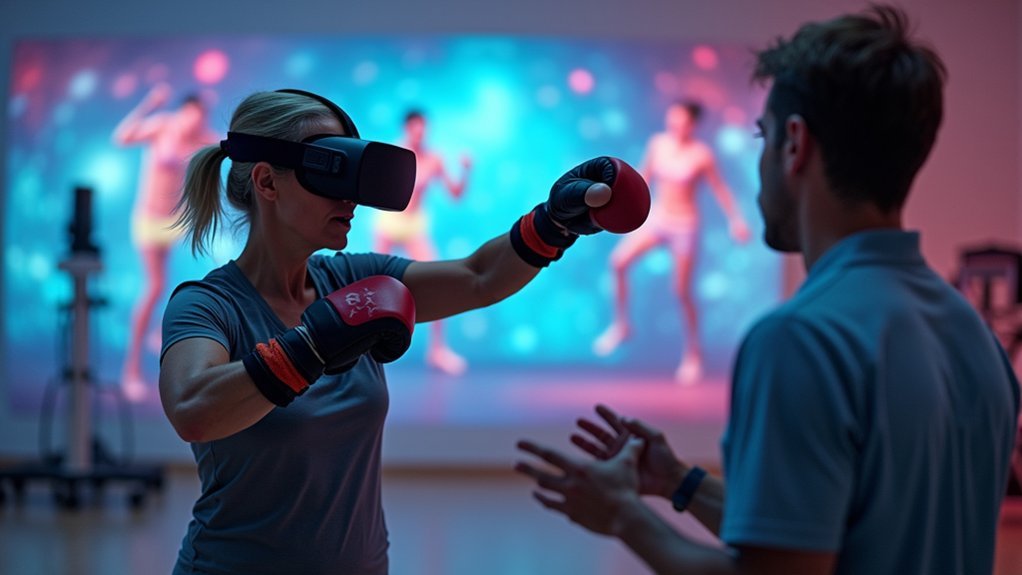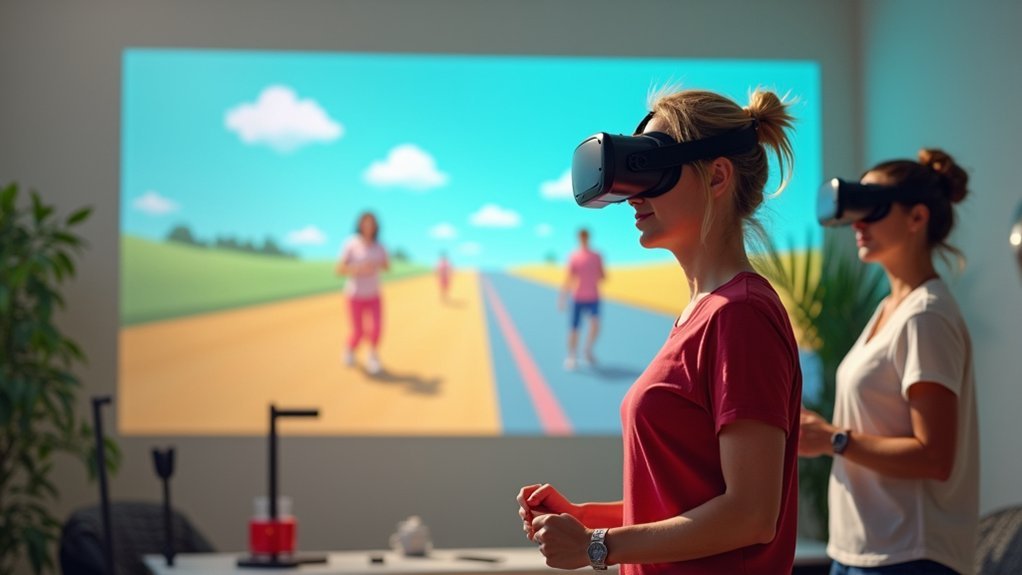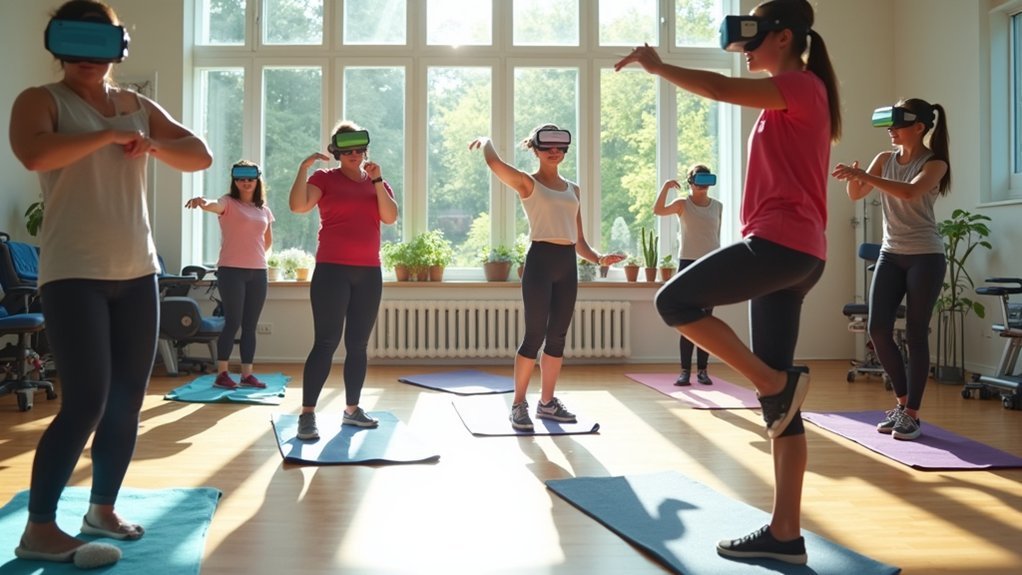Virtual reality transforms stroke rehabilitation with five effective workout options: upper limb boxing exercises, balance-focused snowboarding simulations, interactive soccer goalkeeping for standing stability, guided walking environments, and customized motion games. These immersive workouts enhance neuroplasticity, improve coordination, and build functional strength through engaging, purposeful movements. You’ll experience greater motivation and faster recovery compared to conventional therapy, with clinical evidence supporting significant mobility improvements. Discover how these targeted VR approaches can revolutionize your recovery journey.
Virtual Boxing for Upper Limb Rehabilitation

Three key factors make virtual boxing an effective rehabilitation tool for stroke survivors with upper limb impairments.
First, it creates an immersive environment that markedly boosts your motivation and participation compared to conventional exercises. You’ll engage in purposeful movements that directly translate to improved daily activities. Research suggests that more intensive VR therapy sessions conducted five days a week show greater improvements in upper limb function compared to less frequent interventions.
Second, virtual boxing incorporates both bilateral and unilateral arm movements, enhancing your strength, coordination, and range of motion specifically in affected limbs. The real-time feedback helps adjust training intensity to your progress.
Finally, clinical evidence strongly supports its effectiveness. Studies show VR boxing combined with task-oriented training surpasses conventional therapy alone, delivering greater improvements in upper limb mobility, balance, and cognitive function.
You’ll likely experience minimal side effects while gaining functional independence.
Balance-Enhancing VR Snowboarding Exercises
Virtual snowboarding simulations stand at the forefront of balance rehabilitation for stroke survivors by creating dynamic, engaging environments that challenge your stability while minimizing fall risks.
These immersive programs typically involve 30-minute daily sessions over several weeks, with difficulty levels customized to your specific needs.
Research confirms that VR snowboarding greatly improves balance, gait functionality, and activities of daily living.
You’ll experience enhanced vestibular and visual equilibrium, reducing your fall risk while promoting neuroplasticity in areas affected by stroke.
The cognitive engagement required when maneuvering through virtual slopes simultaneously stimulates your brain and body.
Compared to conventional therapy, these immersive snowboarding exercises often produce superior outcomes, especially in longer-term programs.
They’re particularly effective at improving gait adaptability and dual-tasking abilities—essential skills for regaining independence after stroke. A randomized controlled study found that patients performing standing VR activities like snowboarding showed clinically significant improvements on lower extremity function tests compared to sitting VR exercises.
Interactive Soccer Goalkeeping for Standing Stability

Interactive soccer goalkeeping in virtual reality offers stroke survivors a dynamic approach to rebuilding standing stability through engaging, purposeful movements. As you block incoming virtual balls, you’re actually practicing weight-shifting, coordination, and balance in a controlled environment.
This VR application adjusts difficulty levels as your abilities improve, making rehabilitation progressive and challenging. You’ll benefit from high-repetition training without the monotony of traditional exercises. This approach aligns with key principles of motor learning theory that support skill retention in stroke rehabilitation.
Research shows these goalkeeping movements trigger neuroplasticity—your brain’s ability to form new neural connections.
The game’s immersive nature increases your engagement and motivation, leading to longer, more productive therapy sessions. Clinical trials demonstrate that patients using VR goalkeeping exercises experience significant improvements in standing stability and confidence in real-world movements, ultimately enhancing your independence and quality of life.
Guided Walking Simulations in Safe VR Environments
While standing stability forms a foundation for mobility, regaining your walking ability represents the next essential milestone in stroke recovery. VR walking simulations create risk-free environments where you’ll practice complex gait patterns without fear of falling. Research shows these immersive experiences activate postural control better than conventional therapy. Technologies like NeuRRoVR feature specially designed balance exercises that simulate walking on narrow surfaces without actual falling risks.
| Protocol Type | Duration | Key Benefits |
|---|---|---|
| Standard VR Walking | 45 min, 3x weekly | Improved balance, reduced fall risk |
| Cognitive-Motor Tasks | 6-week program | Enhanced dual-tasking abilities |
| Tightrope Simulation | Progressive difficulty | Better spatial awareness |
| Robot-Assisted VR | 9+ sessions | Increased walking speed, stride length |
You’ll experience faster recovery when VR challenges combine with physical therapy, creating neuroplastic changes essential for mobility restoration. The progressive difficulty keeps you engaged while building confidence for real-world walking.
Customized Motion Games for Progressive Mobility Improvement

Customized motion games represent a significant advancement in post-stroke mobility therapy, transforming repetitive rehabilitation exercises into engaging, purpose-driven activities.
These VR exergames are specifically designed for your unique needs, focusing on targeted movements for your weakened limb or encouraging bilateral coordination.
The user-centered design process guarantees games match your physical capabilities while providing progressive challenges. You’ll experience familiar scenarios that reduce cognitive load while maintaining your physical engagement.
Game mechanics incorporate customized feedback and reward systems that boost your motivation and adherence. Iterative playtesting with stroke survivors ensures the games effectively address upper limb rehabilitation needs.
Clinical data confirms the effectiveness, with significant motor function improvements compared to conventional therapy alone.
You’ll benefit from high-repetition movement practice that’s critical for neuroplasticity, whether you’re in a clinical setting or using an accessible at-home VR setup.
Frequently Asked Questions
How Does Patient Age Affect VR Rehabilitation Outcomes?
Your age impacts rehabilitation outcomes; you’ll typically recover better when you’re younger due to higher motivation and fewer cognitive challenges. VR training must be tailored to address age-specific barriers for maximum effectiveness.
What Are the Costs of Implementing VR Systems in Rehabilitation Facilities?
You’ll find VR systems range from $300-1,500 for basic headsets to $50,000+ for medical-grade systems. Monthly software subscriptions cost $30-500, and you’ll need to budget for staff training too.
Can Home-Based VR Therapies Be as Effective as Clinical Sessions?
Yes, you can achieve similar benefits with home-based VR therapy when you maintain proper intensity and frequency. Research shows comparable motor improvements, especially when you combine it with conventional therapy and receive remote monitoring support.
How Long Do Mobility Improvements Last After VR Therapy Ends?
You’ll typically retain mobility improvements for weeks to months after VR therapy ends. Benefits last longer with extended intervention periods, combined conventional therapy, and consistent practice, though gains gradually decline without maintenance activities.
Are There Psychological Benefits Beyond Physical Improvements From VR Rehabilitation?
Yes, you’ll experience significant psychological benefits from VR rehabilitation including increased motivation, reduced depression, and greater engagement in therapy. VR’s immersive environments exploit your brain’s embodied simulation mechanism, making therapy more enjoyable and emotionally satisfying.
In Summary
You’ve now discovered powerful VR workouts that can transform your stroke recovery journey. These digital therapies offer engaging alternatives to traditional rehabilitation exercises, making your mobility progress more enjoyable. Whether you’re working on upper limb strength, balance, or walking skills, VR technology provides a safe, customizable environment for your needs. Try incorporating these immersive experiences into your recovery routine to boost your rehabilitation outcomes.





Leave a Reply